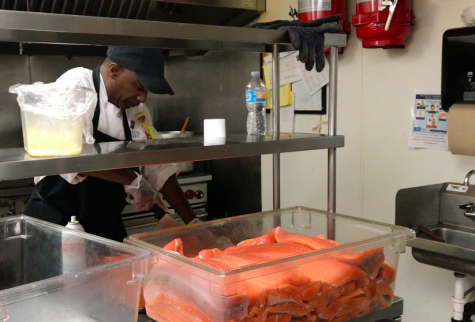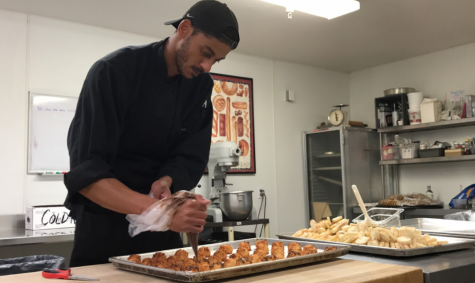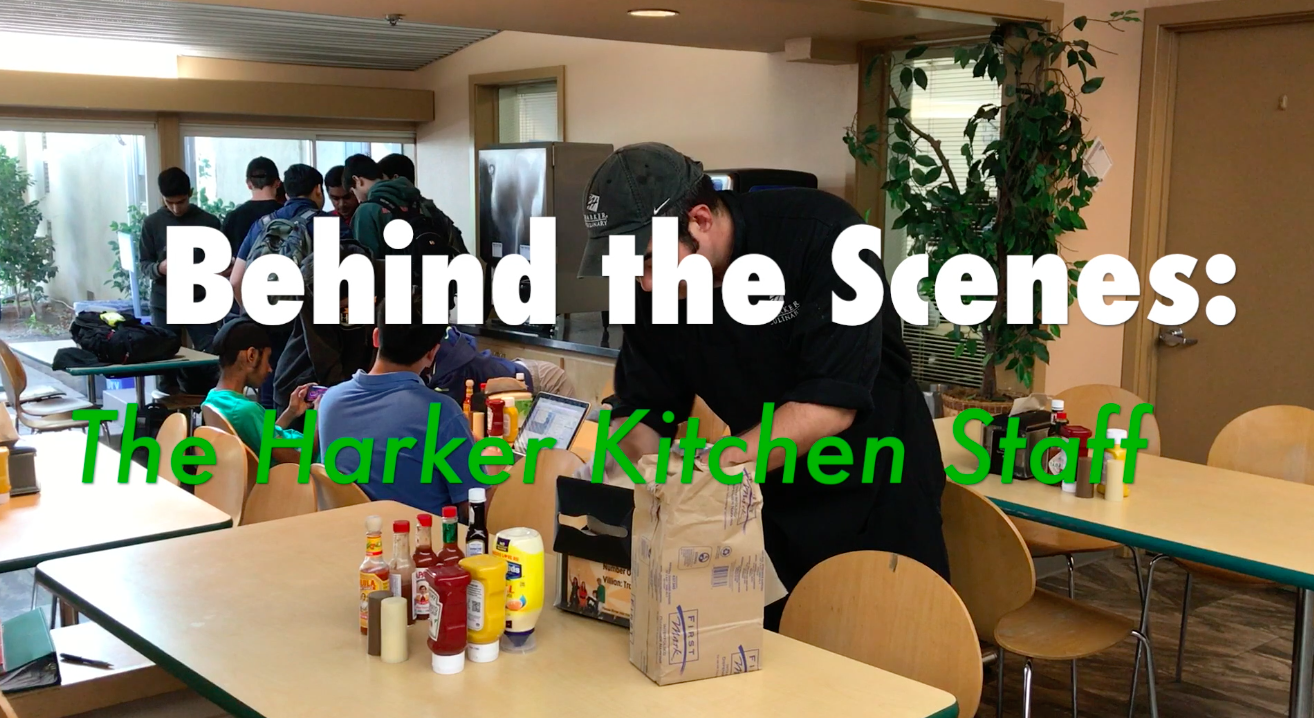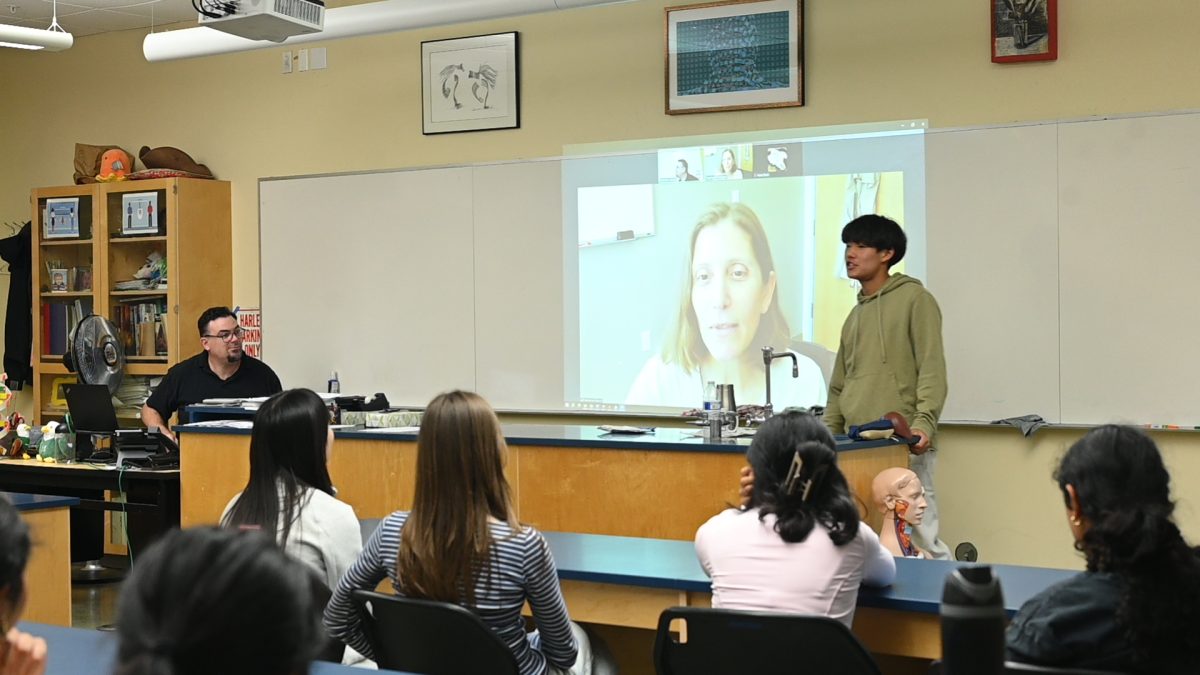From Package to Platter: Behind the scenes of kitchen staff
September 6, 2017
A chef adds salt to the tub of steak-cut fries and begins shoveling the thickly-cut slices into small paper containers. Sixteen of the 18 busy members of the upper school kitchen staff hustle around the kitchen, delicately but efficiently placing plates of steaming salmon in neat rows on the shiny counter as they wait for the mob of hungry students to rush into Manzanita Hall.
The kitchen staff values preparation and understand its importance in the culinary world in particular. They begin preparing for lunch the day before so as to reduce the workload the next day.

A chef prepares lunch by cutting salmon. The kitchen staff often start preparations for lunch the day before the food is served.
“The most important thing in culinary terms is called mise en place [and] it means [that] everything’s in its place; everything has a place, so being organized––that’s the most important thing,” Executive Chef Stephen Martin said. “We base all our production on being organized and using fresh ingredients and batch cooking; we start our preparation the day before, then we cook in batches the day of so we try not to overcook and we try not to overproduce.”
The kitchen staff enjoy taking on the challenge of serving the large Harker community.
“It’s very fun, it’s interesting to see what everybody tends to go for,” prep chef Richelle Periandri said. “The challenging part is [that] we have so many items. For example, if you say you want something specific, we’re like, ‘Oh now we have to run and go get this one real quick,’ so that gets a little hard, but overall it’s fun. We interact with you guys, so it’s really neat to talk to you sometimes if you have a second.”
Producing approximately 90,000 meals a month for school lunches, staff meals and catering, the kitchen staff makes sure that fresh, nutritious food is provided to faculty and students every day.
https://www.youtube.com/watch?v=8t6q1cPa_Tk
“At first it would be overwhelming if you don’t really have experience working in the kitchen, but I went to culinary school and I’m still going so I have an associate’s degree in this,” Daniel Arenas, a former kitchen intern, said. “I’ve [also] worked in various other restaurants and for me, it’s rather relaxed, easy because we have everything prepared, we have a set time, we know how many students are here so we always do the same amount.”
Martin offers the other members of the kitchen staff the opportunity to participate in creating recipes and menus, creating a cooking style special to the Harker School.

A chef makes dessert for the Harker community. In addition to making and serving food, the kitchen staff also comes up with the menu for lunch.
“A lot of times, we don’t have standardized recipes, we’ll have some Chef Steve recipes that have been here forever and ever and ever, and we have people who have been here for a long time, so we created a pretty unique style of cooking and creating recipes and menus,” Martin said.
Once a month, the chefs prepare a meal for 20 children and 5 staff members as part of a program called Stand Up for Kids, an organization which offers aid to homeless teenagers.
“We prepare a dinner for them once a month, and, if we have any leftover foods from various caterings, we call them and supply their facility for the weekend,” Martin said. “On a Friday night, if we have anything leftover that we’re not going to use, we supply food for them.”
The chefs work through the morning to prepare for the lunchtime rush, cooking and making sure the tables are set up neatly. They also label the variety of dishes and note down any possible products that may cause allergies on campus. As the clock ticks closer to lunchtime, the chefs then make sure that the daily pizza is delivered and the pasta is ready. They finish preparations at about a half hour before lunch starts.
The bell rings, and chatter soon fills the cafeteria as a wave of students enters Manzanita Hall. Some students rush to the pizza counter, others head towards the main entrees and a few grab desserts first before joining the mobs surrounding the other counters. Chefs running the Edge work quickly, swiftly preparing, plating and setting the dishes in neat rows onto the counter. Meanwhile, the pastry chef restocks the dessert table with an assortment of sweets. A teacher stands by the entrance to the Edge, controlling the flow of the students into the area. The pattern repeats for the first part of lunch until the stream of students approaching the counters slowly diminishes as they begin to finish their lunches. A line to return plates and silverware begins to form.

Food is served in the main dining hall in Manzanita. The kitchen staff’s work often includes preparing beforehand and cleaning up after the lunch period is over.
The once-starving Harker community is satisfied and the kitchen staff initiates their ritual clean up, closing each food station one by one. The chefs decide whether they can repurpose any of the leftover ingredients the next day and dispose of any that will not be used. They rinse the dishes, sweep the floor, wipe down the tables and countertops and start preparations for the next day.
This piece was originally published in the pages of The Winged Post on September 6, 2017.


















![“[Building nerf blasters] became this outlet of creativity for me that hasn't been matched by anything else. The process [of] making a build complete to your desire is such a painstakingly difficult process, but I've had to learn from [the skills needed from] soldering to proper painting. There's so many different options for everything, if you think about it, it exists. The best part is [that] if it doesn't exist, you can build it yourself," Ishaan Parate said.](https://harkeraquila.com/wp-content/uploads/2022/08/DSC_8149-900x604.jpg)




![“When I came into high school, I was ready to be a follower. But DECA was a game changer for me. It helped me overcome my fear of public speaking, and it's played such a major role in who I've become today. To be able to successfully lead a chapter of 150 students, an officer team and be one of the upperclassmen I once really admired is something I'm [really] proud of,” Anvitha Tummala ('21) said.](https://harkeraquila.com/wp-content/uploads/2021/07/Screen-Shot-2021-07-25-at-9.50.05-AM-900x594.png)







![“I think getting up in the morning and having a sense of purpose [is exciting]. I think without a certain amount of drive, life is kind of obsolete and mundane, and I think having that every single day is what makes each day unique and kind of makes life exciting,” Neymika Jain (12) said.](https://harkeraquila.com/wp-content/uploads/2017/06/Screen-Shot-2017-06-03-at-4.54.16-PM.png)








![“My slogan is ‘slow feet, don’t eat, and I’m hungry.’ You need to run fast to get where you are–you aren't going to get those championships if you aren't fast,” Angel Cervantes (12) said. “I want to do well in school on my tests and in track and win championships for my team. I live by that, [and] I can do that anywhere: in the classroom or on the field.”](https://harkeraquila.com/wp-content/uploads/2018/06/DSC5146-900x601.jpg)
![“[Volleyball has] taught me how to fall correctly, and another thing it taught is that you don’t have to be the best at something to be good at it. If you just hit the ball in a smart way, then it still scores points and you’re good at it. You could be a background player and still make a much bigger impact on the team than you would think,” Anya Gert (’20) said.](https://harkeraquila.com/wp-content/uploads/2020/06/AnnaGert_JinTuan_HoHPhotoEdited-600x900.jpeg)

![“I'm not nearly there yet, but [my confidence has] definitely been getting better since I was pretty shy and timid coming into Harker my freshman year. I know that there's a lot of people that are really confident in what they do, and I really admire them. Everyone's so driven and that has really pushed me to kind of try to find my own place in high school and be more confident,” Alyssa Huang (’20) said.](https://harkeraquila.com/wp-content/uploads/2020/06/AlyssaHuang_EmilyChen_HoHPhoto-900x749.jpeg)






![LALC Vice President of External Affairs Raeanne Li (11) explains the International Phonetic Alphabet to attendees. "We decided to have more fun topics this year instead of just talking about the same things every year so our older members can also [enjoy],” Raeanne said.](https://harkeraquila.com/wp-content/uploads/2025/10/DSC_4627-1200x795.jpg)





Natasha • Jul 23, 2017 at 7:34 pm
I enjoyed watching your video, and I will be sure to acknowledge the chef’s hard work 😉